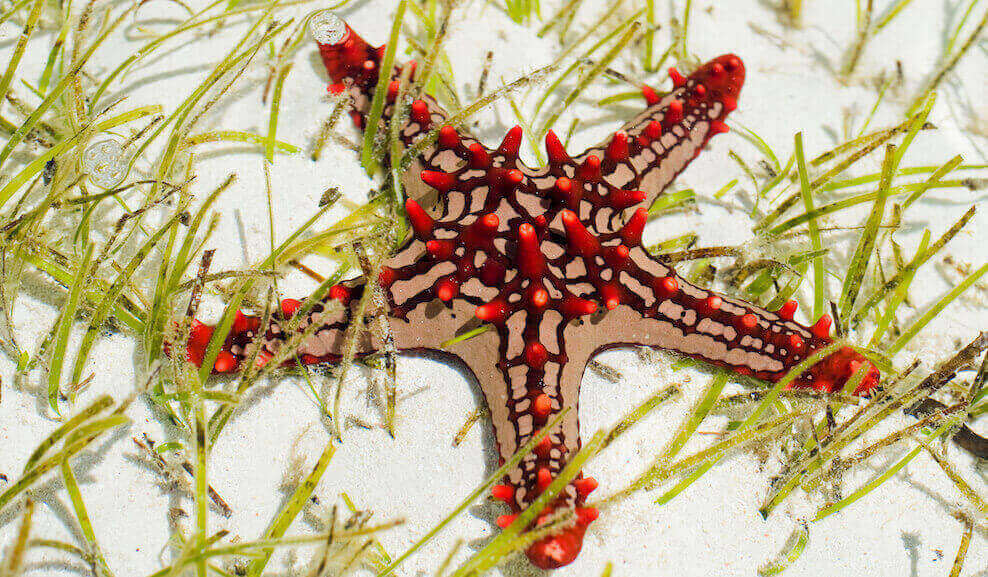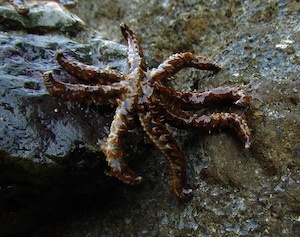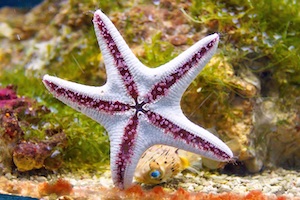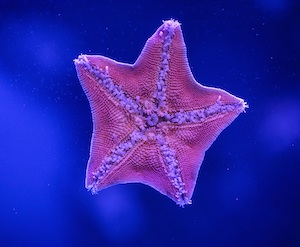
Starfish is one of the sea’s fascinating creatures, often seen in pretty much every shore even in the Atlantic and Antarctic oceans. The most variety thrives in the Pacific Ocean.
Contrary to its name, starfish are not classified as fish but also called sea stars. Usually, they are with five limbs formed in the shape of a star, and some rare types have more, like the Sun Starfish, which can have up to 40 arms.
The starfish belong to the Echinoderms family, a type of invertebrate (animals that do not have any bone).

Many people wonder how starfish can move on their own. On its underside, there are so-called tubed feet that they use to move around. Unlike fish, starfish cannot swim and do not have certain parts that most fish do like gills, scales, and fins. These called ‘ambulatory feet’, which are very much like the suckered tube feet attached to the tentacles of octopi and squids. These are dotted all over the other side of its body; it uses them to maneuver their way around the ocean floor. Also, on the ends of each limb, some eyes are sensitive to light. The number of its arms corresponds to its eyes; for example, a sun star with over 30 limbs has 30 eyes.
There are over 2000 species of starfish in the world.
Besides having no bones, starfish also don’t have a brain, but they contain quite a complex nervous system that controls the eyespots on each limb’s end, regenerate and eat by retracting their stomach to consume prey.
Every species differ in their preference and growth; known to expand from 4.7 to 9.4 inches and grow up to 11 pounds.
Depending on how you care for your starfish, they can live up from 5 to 35 years.
Starfish Characteristics
1) Their Eyes

Despite our inability to detect these at first glance, starfish have eyes that located at the tip of their every limb, and as they grow more arms, so do the number of their eyes. Unlike human eyes, these are much more camouflaged and are called eyespots, which are quite sensitive to light. These easily spotted since these look like red spots. These eyespots cannot detect detail but simply sense the light from the dark. It is sufficient due to the type of environment that they live.
2) Their Skin
Though they lack bones and brain, starfish have tough skin covering their surfaces. Like our teeth, starfish skin is sustained by calcium, or calcium bicarbonate to be exact, which also gives the characteristic of its thorns or tiny spines on their skin. It varies per species, whether it be thickness, pattern, or color. Some are even poisonous to the touch and with many large protruding thorns like the crown of thorns starfish.
Their skin is their defense mechanism against predators from the sea, land, and air, such as fishes, mammals, birds, and sea otters.
3) Their Circulatory System
One of the many fascinating facts about starfish besides having no brain and bones is utilizing a water vascular system. Meaning they have no blood. This water vascular system is responsible for pumping the nutrients into its body from the food and prey it digests.
Seawater is what runs in a starfish’s veins through the sieve plate, or the madreporite, which is like a trap door and can see on a starfish as a light-colored spot on its top.
4) Their Feet
Tubed feet or ambulatory feet are located all over a starfish’s underside, and there are hundreds of these. Like their circulatory system, these suckered tubed feet are run by seawater, which comes in through the starfish’s madreporite located at its top side.
These suckered tubed feet help in trapping and attaching the starfish to its prey, which poses quite a hold on its food like mussels and clams.
5) They Regenerate
Among all the fantastic facts about the sea, starfishes have the unique ability to regenerate broken arms and grow additional ones. It is probably one of the most famous tidbits of fact about starfish.
Like the common lizard, which has a mechanism of intentionally detaching its tail, the starfish detaches its limbs to distract its predator. Once it successfully does so, it manages to regrow its arm in a certain amount of time. This mechanism is called autotomy.
The starfish can regrow its arm in a year. The limbs of a starfish house most of the vital organs, and this signifies that even from one arm, a starfish can be reborn along with the central disc part.
Their diet

1) Out in the Ocean
There is a wide variety of food that is made available in pet stores and markets, even for species like the starfish. The starfish diet varies per species, depending on their preference–some are predators targeting small fishes, some are scavengers, and some don’t stray from most fish’s diet.
Most starfish varieties are carnivorous and prey on other fish, hunting on smaller beings such as sea urchins, fish, plankton snails, sea cucumbers, mussels, clams, anemones, coral polyps, and crustaceans. These are often lodged into rocks or burrowed in the sand to quickly reach and capture them since their movements are quite slow. A starfish regularly eats around 50 clams per week!
Other species of starfish scavenge for rotting matter on shores and beaches, which is also another easy way of finding food. However, these have lower nutritional value and the chances of having it snatched away by a faster predator.
Besides scavenging and preying on creatures on the bottom of the sea, some sea stars hunt by drifting in the water; they can catch plankton, sea sponges, and coral.
2) In the Tank
These are among the sought-after attractions in the aquarium, primarily because of their attractive colors and shape. When taken care of properly and fed a consistent and nutritious diet, it can live for years.
Unlike most of the fish you keep in your tank, starfish cannot live on fish flakes and pellets and must have food that is pretty much like their diet in the wild. In captivity, mollusks are often the food for sea stars, so dropping some snails, mussels, and clams purchased from the market would make your starfish happy.
Reminder: be sure to clean and rinse those things before feeding them to your starfish since they may carry pathogens that can affect your starfish’ health and other fish in the tank. Other food also consists of prawns, shrimp, and algae.
How many times you need to feed your starfish will depend on the species since some have survived weeks without food, and some need to consume daily. You need to properly observe your starfish’s behavior and do some research on the specific type of starfish you have and then find the appropriate feeding routine to ensure that you don’t underfeed or overfeed your starfish. Once you’ve done it, it’ll surely be an enjoyable experience to see your starfish active and prowl for its prey and satisfied with its meal.
Starfish: How it eats
Now you may be wondering, with all the facts we’ve laid down on how starfish would prey on shelled species such as clams, mussels, and snails, but how do they do it?
Sea stars do not have visible orifices to take in food besides the detectable eyespots at the tip of each limb, but with this organ, they can undoubtedly find food.
The eyespots located at each tip of the starfish arms are sensitive to light, and they make use of these to feel and make sense of their surroundings in search of food. Their bottoms consist of hundreds to thousands of tube-like feet, enabling them to move around, though slowly on the ocean floor, shores, and indeed helpful in grabbing prey. They move with their tube arms, holding on to rocks that they happen to come across, and when they’ve found a lodged clam, these tubed feet can pry their shells open.
One more thing about starfish anatomy is that they have two stomachs, namely the cardiac and pyloric. Once they captured the prey, the starfish will clasp it with its limbs and tubed feet. The starfish then enables the cardiac stomach to spread wide enough to put it inside their mouth and then digest it part by part.
Once captured, they will proceed to pull the shells apart to a slight opening for shelled prey, and then it manages to shoot its stomach into the shell, releasing a chemical that dissolves the soft tissues of the mollusk in the shell. This chemical is the starfish’ digestive enzymes; once it touches its food, it gets absorbed by the cardiac stomach.
After completed, the cardiac stomach returns to its place, and then it is the pyloric stomach turns to do its work.
This method is quite useful even towards larger prey, dissolving first the tissues outside the starfish itself and then absorbs it back inside in the food’s liquid form.
A surprising fact about the starfish and their ability to detach a limb is they can also do this with the cardiac stomach. If it doesn’t like its food, it discards the cardiac stomach and proceeds to grow another one. Starfish are considered experts in unlocking shelled food with their limbs and tubed feet to eat the soft flesh inside.
Conclusion
With all these fascinating facts and more about the starfish, they prove to be mysterious and beautiful. In captivity, they are peaceful creatures. However, they are considered high maintenance and are taken on by experienced aquarists and fish keepers since close observation on their care, diet, and tank requirements should monitor.
If you’re considering keeping one, the minimum requirement for its tank is 100 gallons. Most cases for their death is that they are put in smaller tanks with fewer rocks, in this kind of habitat, they tend to starve.
In terms of feeding, this varies on the type of starfish. Some could easily feed, and some are more finicky in their food. Doing your research on what species of starfish you have is vital in successfully taking care of your starfish. The study will also help you introduce your starfish to its habitat and build affinity with other fishes.



